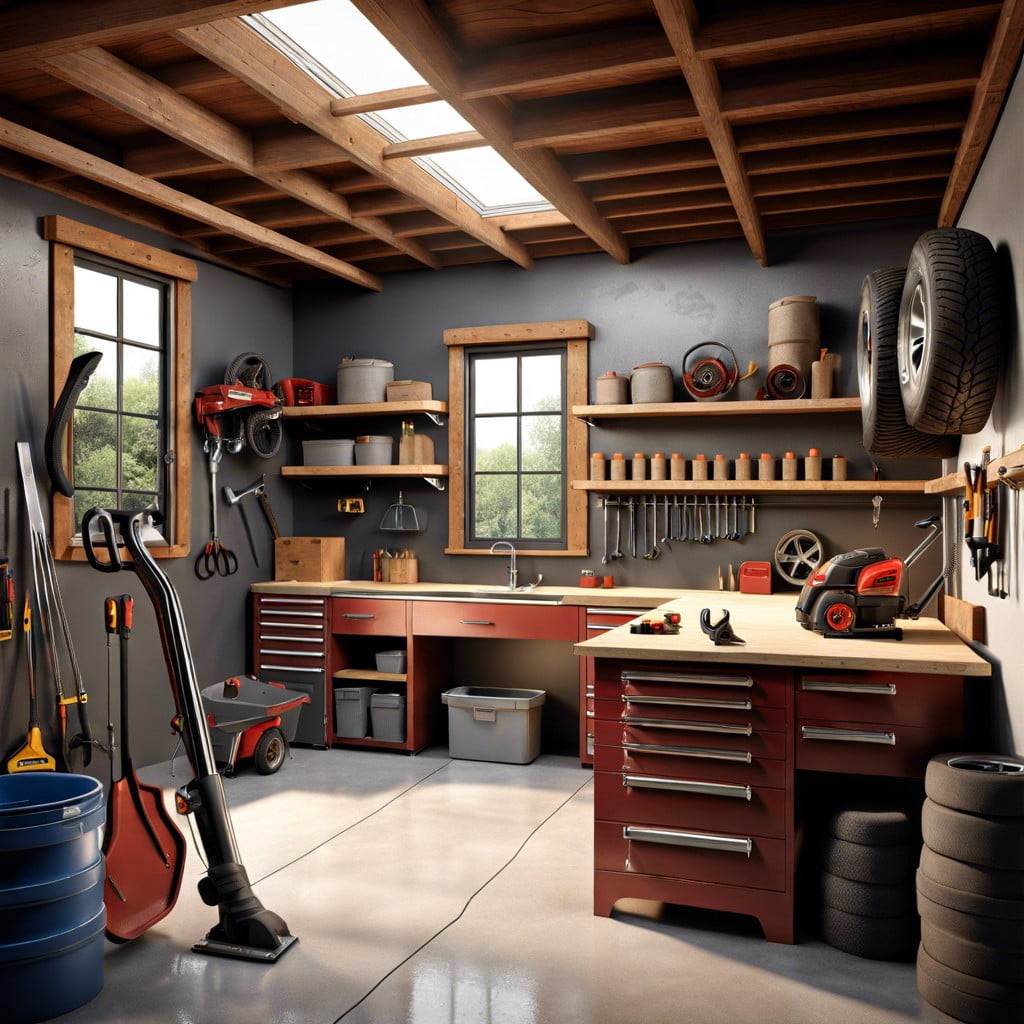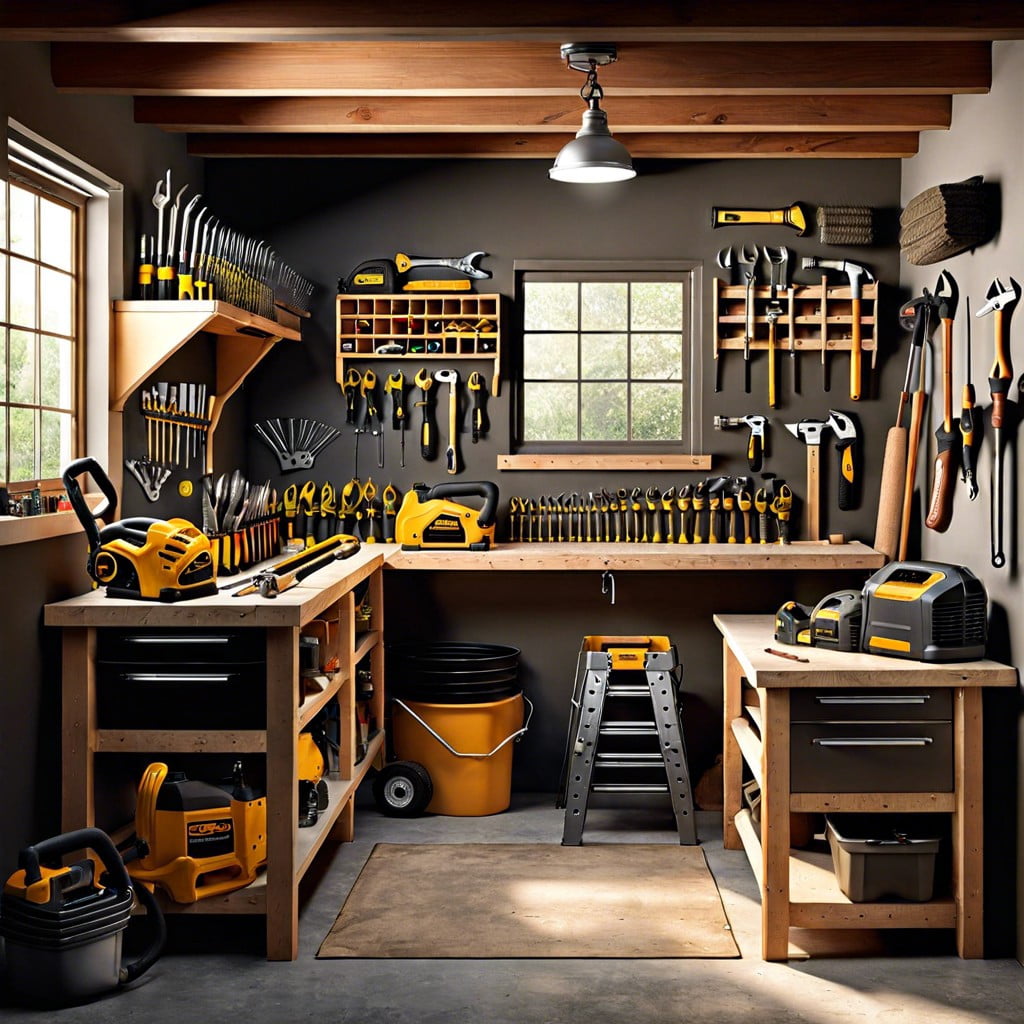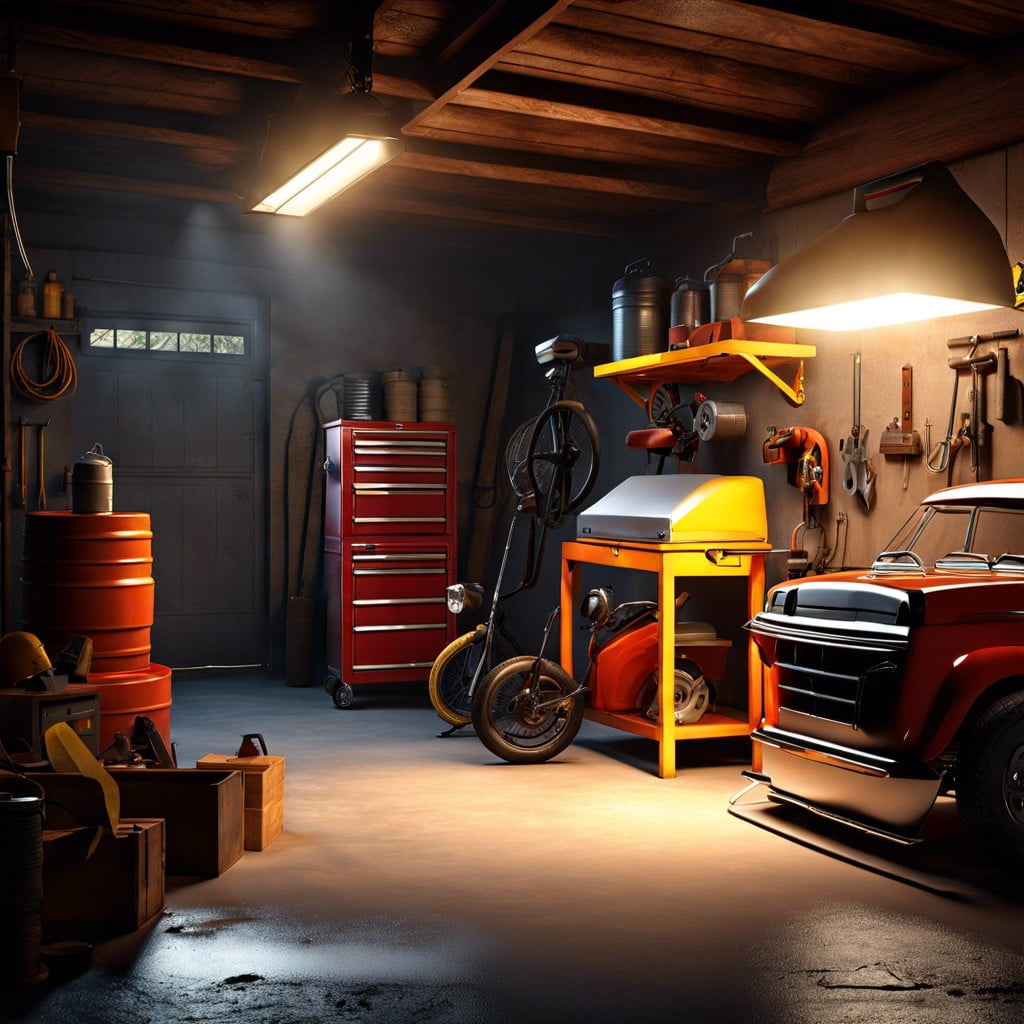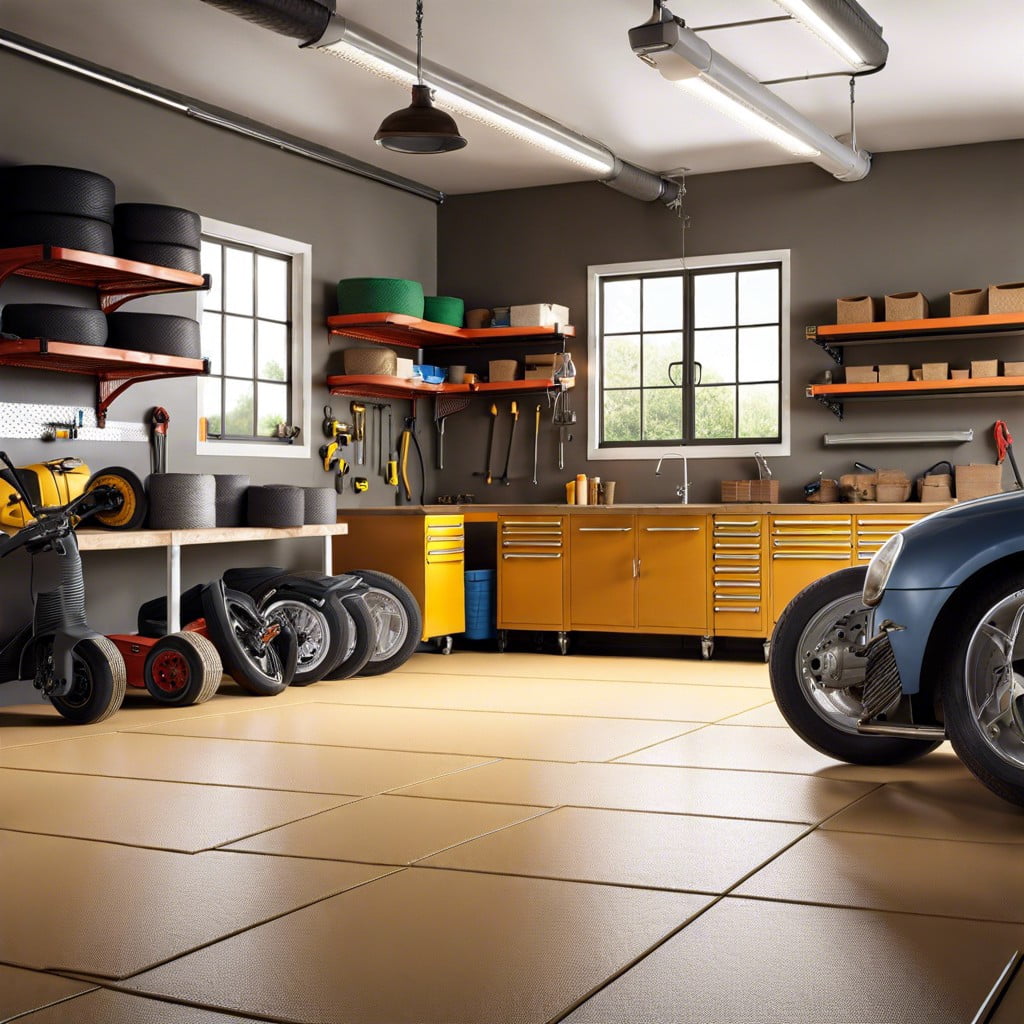Explore the exciting potential of transforming an outdated garage into a personalized workspace because your creativity deserves a place to flourish.
Key takeaways:
- Design for ergonomic movement and accessibility
- Efficient tool organization for easy access and workflow
- Adequate lighting for visibility and safety
- Flooring options to reduce fatigue and minimize tripping hazards
- Storage solutions and slip-resistant surfaces for safety
Ergonomic Considerations for Ease of Movement

Designing a garage space to minimize strain and maximize mobility involves careful planning. Install work surfaces at varying heights to accommodate both standing and seated tasks, reducing the need to bend or stretch excessively.
Leave ample clearance around equipment and work areas to support a full range of motion without obstacles. Choose rolling tool chests over stationary ones to bring tools directly to the work site, limiting the need for constant reaching or walking back and forth.
Equip drawers and cabinets with easy-to-grip handles and drawer pulls, especially beneficial for arthritic hands. Install lever-style door handles which are easier to operate than knobs.
Finally, arrange frequently used items within arm’s reach to create a smooth workflow and prevent unnecessary movement.
Tool Organization for Efficiency

Strategically placing commonly used tools within arm’s reach minimizes unnecessary movement and can reduce strain. Utilizing wall-mounted pegboards or magnetic strips for hand tools not only saves space but keeps them visible and orderly.
Drawer organizers in tool chests can keep smaller items tidy, while larger equipment benefits from designated zones marked with floor tape. Installing a shadow board, where the outline of each tool is drawn or painted, ensures every item has a place and highlights what’s missing at a glance.
Mobile tool carts can also be advantageous, bringing tools directly to the work area and reducing the need to travel back and forth.
Garage Lighting for Visibility and Safety

Adequate illumination is critical for preventing accidents and eye strain. Opt for LED lights that provide bright, even coverage and consume less energy.
Consider task lighting at workbenches and around tools for detailed work. Ensure light switches are easily accessible, possibly with illuminated or larger switches to aid those with diminished eyesight or dexterity.
Motion sensor lights can offer convenience and safety for hands-free operation, lighting up the garage as soon as movement is detected. Lastly, distribute lights evenly to avoid dark spots and shadows where hazards could lurk unnoticed.
Flooring Options to Reduce Fatigue

Anti-fatigue mats provide cushioning that eases stress on the legs and back, particularly beneficial when standing for long periods.
Epoxy flooring, as a smooth and even option, minimizes tripping hazards and is effortless to clean, reducing the strain associated with maintenance.
Interlocking rubber tiles offer a DIY-friendly installation, their inherent softness and shock absorbency shield joints during movement.
For an added layer of comfort, consider placing carpet tiles in areas where prolonged standing occurs, as they offer a softer surface and can be easily replaced if damaged.
Regularly rotating standing positions, along with the strategic placement of these flooring options, can significantly mitigate fatigue in a garage workspace.
Workbench Design for Comfort and Accessibility
A height-adjustable workbench is key, allowing for both seated and standing work, accommodating various physical conditions. Ample knee clearance is crucial, so opt for open designs or recessed cabinets. Rounded corners minimize the risk of injury. Consider incorporating pull-out drawers instead of lower cabinets to provide easy access to tools without bending or kneeling. Accessibility can be further improved by installing a pegboard with outlines for tools above the bench, ensuring everything has a place and is within easy reach. For those with hand dexterity issues, large, easy-to-grip handles on drawers and tool organizers are advantageous.
Insulation and Heating for Year-Round Use
To maintain a consistent temperature during both sweltering summers and frigid winters, proper insulation is key. Adding insulation to walls and the ceiling traps heat during cold months while keeping the garage cooler when temperatures rise. Consider materials such as fiberglass, cellulose, or foam board, each with its own benefits regarding thermal performance and ease of installation.
For heating, options include forced-air heaters, infrared heaters, or portable space heaters—each suitable for different garage sizes and heating needs. A programmable thermostat can offer additional convenience, allowing temperature regulation according to the time of day and ensuring the space is always comfortable when in use.
Additionally, weather stripping around doors and windows prevents drafts, further enhancing thermal efficiency. Double-glazed windows can also help in retaining heat within the space without compromising natural light.
Remember, adequate ventilation is necessary to avoid the buildup of fumes from vehicles or tools, especially when the space is being heated.
Storage Solutions for Limited Mobility
Opt for sliding drawers and pull-out shelves, which allow easy access to tools and supplies without the need to reach deep into cabinets.
Install pegboards with hooks at a mid-level height to hang commonly used tools, ensuring they are within easy reach.
Consider a motorized storage lift system, which can bring down items from higher shelves at the push of a button.
Utilize clear, labeled bins for organizing small items, reducing the need to stoop or crouch to identify contents.
Choose carts on wheels for transporting heavy items across the garage to minimize lifting and carrying.
Slip-Resistant Surfaces for Injury Prevention
Upgrading the flooring to materials with higher traction can dramatically reduce slip hazards. Epoxy coatings mixed with grit additives offer a balance of durability and grip, even when wet.
For an easier install, interlocking rubber tiles provide a DIY-friendly solution that also cushions against falls. It’s crucial to keep the floor clear of spills and debris, so incorporating absorbent mats in high-risk areas, like beneath vehicles, can quickly contain and control slick substances.
For budget-friendly options, anti-slip floor treatments can enhance the existing surface without a complete overhaul. Regular monitoring for wear and tear ensures these slip-resistant measures remain effective, safeguarding the garage against accidents.
Fire Safety Measures in a Garage Environment
Store flammable liquids such as gasoline, paint thinners, and oils in clearly labeled, non-glass safety containers. Position these away from any heat sources, including direct sunlight, and ensure they are tightly sealed when not in use.
Install a smoke detector and keep a fire extinguisher, class B or C, easily accessible and within reach in the event of a fire. Regularly check the expiration dates and conduct maintenance checks as recommended by the manufacturer.
Keep electrical systems up to code and outlets in good condition. Avoid overloading circuits with multiple power tools and manage cords to prevent tripping hazards or damage.
Designate a non-flammable area for activities such as welding or soldering, equipped with fire-resistant shields or curtains.
Ensure a clear and unobstructed path to the garage exit to enable quick evacuation. Regularly practice an emergency escape plan to reinforce the route and actions to take in case of a fire.
Maintaining a Safe Garage Environment – Regular Checks and Balances
A well-maintained garage is crucial for safety and efficiency. Regularly inspect electrical cords for wear and tear, and immediately replace any that are frayed or damaged. Keep a functional fire extinguisher within easy reach, and familiarize yourself with its use.
Periodically check for gas leaks or spills, and ensure that all flammable liquids are stored in approved, sealed containers. Verify that the garage door opens smoothly and the auto-reverse mechanism functions properly to prevent accidents. Clear pathways of obstacles to avoid tripping hazards and ensure that all tools and equipment are stored securely after use to prevent injuries from loose items.
Finally, schedule annual inspections for any heating systems to prevent carbon monoxide buildup, ensuring a secure environment year-round.
FAQ
What is the old person car stereotype?
The old person car stereotype refers to the notion that certain types of cars are more appealing to older individuals, and are consequently harder to sell to a younger demographic.
How can garage design address the specific needs of older individuals?
Garage design can address the specific needs of older individuals by implementing features such as non-slip flooring, adequate lighting, accessible storage solutions, wider walkways for mobility aids, and easy-to-use door mechanisms.
What are some features of an 'old man's garage' that make it unique?
An 'old man's garage' is typically characterized by a spacious design, robust tool organization, vintage memorabilia, workbench area, and often features comfortable seating for leisure time.
How can modern garage improvements benefit the elderly?
Modern garage improvements can benefit the elderly by enhancing safety, accessibility, and convenience through features like automatic door openers, slip-resistant floors, and improved lighting.